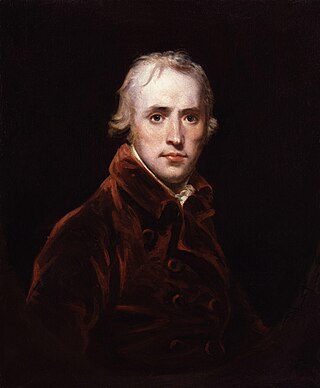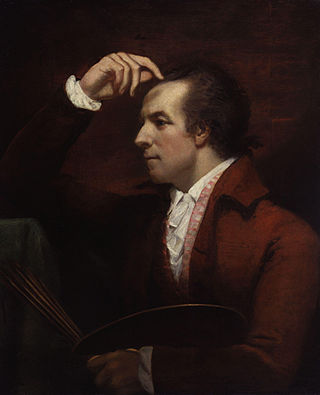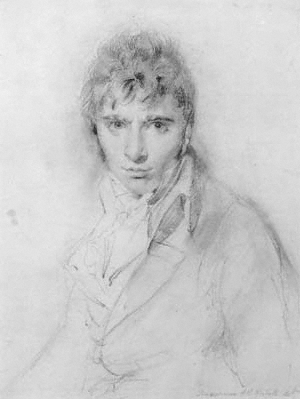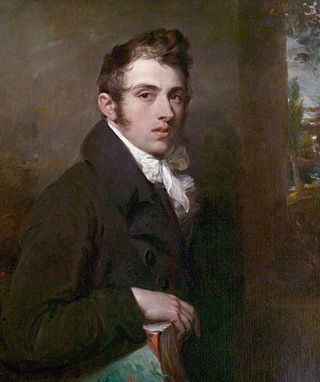
Thomas Phillips RA (18 October 1770 – 20 April 1845) was a leading English portrait and subject painter. He painted many of the great men of the day including scientists, artists, writers, poets and explorers.

Thomas Phillips RA (18 October 1770 – 20 April 1845) was a leading English portrait and subject painter. He painted many of the great men of the day including scientists, artists, writers, poets and explorers.

Phillips was born at Dudley, then in Worcestershire. Having learnt glass-painting in Birmingham under Francis Eginton, [1] he visited London in 1790 with an introduction to Benjamin West, who found him employment on the painted-glass windows of St George's Chapel at Windsor. In 1791 he became a student at the Royal Academy, where, in 1792 he exhibited a view of Windsor Castle, followed in the next two years by the "Death of Talbot, Earl of Shrewsbury, at the Battle of Castillon", "Ruth and Naomi", "Elijah restoring the Widow's Son", "Cupid disarmed by Euphrosyne", and other pictures. [2]
After 1796, he concentrated on portrait-painting. However, the field was very crowded with the likes of John Hoppner, William Owen, Thomas Lawrence and Martin Archer Shee competing for business; consequently, from 1796 to 1800, his exhibited works were chiefly portraits of gentlemen and ladies, often nameless in the catalogue and of no great importance, historically speaking. [1]
In 1804 he was elected an associate of the Royal Academy, together with his rival, William Owen. About the same time he moved to 8 George Street, Hanover Square, London, formerly the residence of Henry Tresham, R.A., where he lived for the rest of his life. He became a royal academician in 1808, and presented as his diploma work "Venus and Adonis" (exhibited the same year), perhaps the best of his creative subjects, apart from "Expulsion from Paradise". Meanwhile, he rose steadily in public favour, and in 1806, painted the Prince of Wales, the Marchioness of Stafford, the "Marquess of Stafford's Family", and Lord Thurlow. In 1807 he sent to the Royal Academy the well-known portrait of William Blake, now in the National Portrait Gallery, London, which was engraved in line by Luigi Schiavonetti, and later etched by William Bell Scott. [1]
His contributions to the academy exhibition of 1809 included a portrait of Sir Joseph Banks (engraved by Niccolo Schiavonetti), and to that of 1814, two portraits of Lord Byron (engraved by Robert Graves, A.R.A). In 1818 he exhibited a portrait of Sir Francis Chantrey, R.A., and, in 1819, one of the poet George Crabbe. His 1822 portrait of Sir Charles Asgill was exhibited at the Royal Academy that same year. In 1825 he was elected professor of painting at the Royal Academy, succeeding Henry Fuseli, and, in order to qualify himself for his duties, visited Italy and Rome in company with William Hilton, R. A., and also Sir David Wilkie, whom they met in Florence. He resigned the professorship in 1832, and in 1833 published his "Lectures on the History and Principles of Painting". [1]
Phillips also painted portraits of Walter Scott, Robert Southey, George Anthony Legh Keck (1830), Thomas Campbell (poet), Joseph Henry Green, Samuel Taylor Coleridge, Henry Hallam, Mary Somerville, Sir Edward Parry, Sir John Franklin, Dixon Denham, the African traveller, and Hugh Clapperton. Besides these he painted two portraits of Sir David Wilkie, the Duke of York (for the town-hall, Liverpool), Dean William Buckland, Sir Humphry Davy, Samuel Rogers, Michael Faraday (engraved in mezzotint by Henry Cousins), John Dalton, and a head of Napoleon I, painted in Paris in 1802, not from actual sittings, but with Empress Josephine's consent, who afforded him opportunities of observing the First Consul while at dinner. Years later in Paris, he was to portray his younger colleague Ary Scheffer (c. 1835, Musée de la Vie romantique, Paris).[ citation needed ]
A self-portrait, exhibited in 1844, was one of his last works. [1]
Phillips wrote many occasional essays on the fine arts, especially for Rees's "Cyclopaedia", and also a memoir of William Hogarth for John Nichols's edition of that artist's "Works", 1808–17. He was a fellow of the Royal Society and of the Society of Antiquaries. He was also, with Chantrey, Turner, Robertson, and others, one of the founders of the Artists' General Benevolent Institution. [1]
Phillips died at 8 George Street, Hanover Square, London, on 20 April 1845, and was interred in the burial-ground of St. John's Wood chapel. He married Elizabeth Fraser of Fairfield, near Inverness. They had two daughters and two sons, the elder of whom, Joseph Scott Phillips, became a major in the Bengal artillery, and died at Wimbledon, Surrey, on 18 December 1884, aged 72. His younger son, Henry Wyndham Phillips (1820–1868) was a portrait painter, secretary of the "Artists General Benevolent Institution", and captain in the Artists' volunteer corps. [1]
Artist and illustrator, John William Wright (1802–1848), was his pupil.

John Hoppner was an English portrait painter, much influenced by Reynolds, who achieved fame as a brilliant colourist.

Sir Francis Leggatt Chantrey was an English sculptor. He became the leading portrait sculptor in Regency era Britain, producing busts and statues of many notable figures of the time. Chantrey's most notable works include the statues of King George IV ; King George III (Guildhall), and George Washington. He also executed four monuments to military heroes for St Paul's Cathedral, London. He left the Chantrey Bequest for the purchase of works of art for the nation, which was available from 1878 after the death of his widow.

James Northcote was a British painter. He became a member of the Royal Academy in 1787, and a member of the Royal Institute of the Netherlands in 1809.

Sir David Wilkie was a Scottish painter, especially known for his genre scenes. He painted successfully in a wide variety of genres, including historical scenes, portraits, including formal royal ones, and scenes from his travels to Europe and the Middle East. His main base was in London, but he died and was buried at sea, off Gibraltar, returning from his first trip to the Middle East. He was sometimes known as the "people's painter".

Sir Henry Raeburn was a Scottish portrait painter. He served as Portrait Painter to King George IV in Scotland.

Richard Westall was an English painter and illustrator of portraits, historical and literary events, best known for his portraits of Byron. He was also Queen Victoria's drawing master.

Sir George Hayter was an English painter, specialising in portraits and large works involving sometimes several hundred individual portraits. Queen Victoria appreciated his merits and appointed Hayter her Principal Painter in Ordinary and also awarded him a Knighthood in 1841.

Sir William Beechey was a British portraitist during the golden age of British painting.

William Hilton was a British portrait and history painter. He is also known as "William Hilton the Younger".

John Raphael Smith was a British painter and mezzotinter. He was the son of Thomas Smith of Derby, the landscape painter, and father of John Rubens Smith, a painter who emigrated to the United States.

Sir William Allan was a distinguished Scottish historical painter known for his scenes of Russian life. He became president of the Royal Scottish Academy and was made a Royal Academician.

William Collins was an English landscape and genre painter. His sentimental paintings of poor people enjoying nature became a posthumous high fashion, notably in the 1870s when his market price rose higher than Constable and stayed so until 1894. Turner, his model, far exceeded him in value.
Sir William Charles Ross was an English portrait and portrait miniature painter of Scottish descent; early in his career, he was known for historical paintings. He became a member of the Royal Academy in 1842.

John Partridge was a British artist and portrait painter. Named 'portrait painter-extraordinary' to Queen Victoria, his pictures depict many of the notable figures of his time.

John Jackson was a British portraitist.

Henry Thomson RA was an English artist and Royal Academician who became Keeper of the Royal Academy.
Maria Spilsbury (1776–1820) was a British artist known for her religious paintings and portraiture.

John Henry Robinson (1796–1871) was an English engraver.

James Ramsay (1789–1854) was a British portrait painter, working in oils.

Robert Graves (1798–1873) was a British engraver.